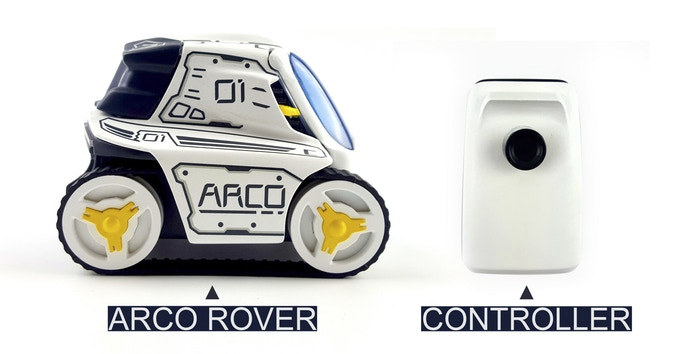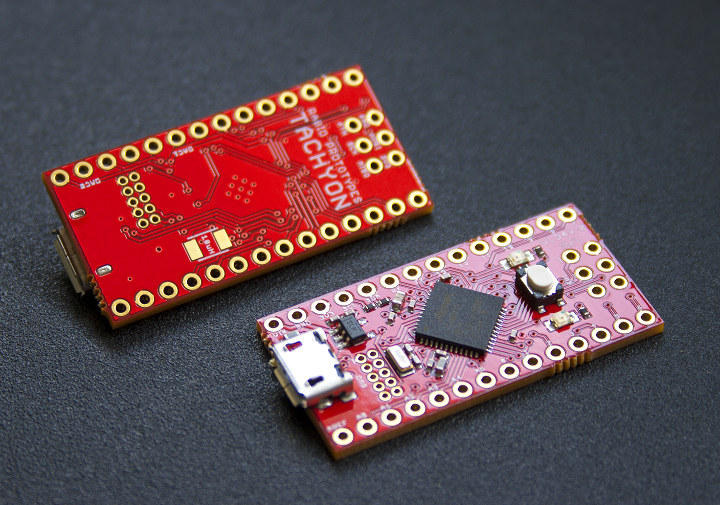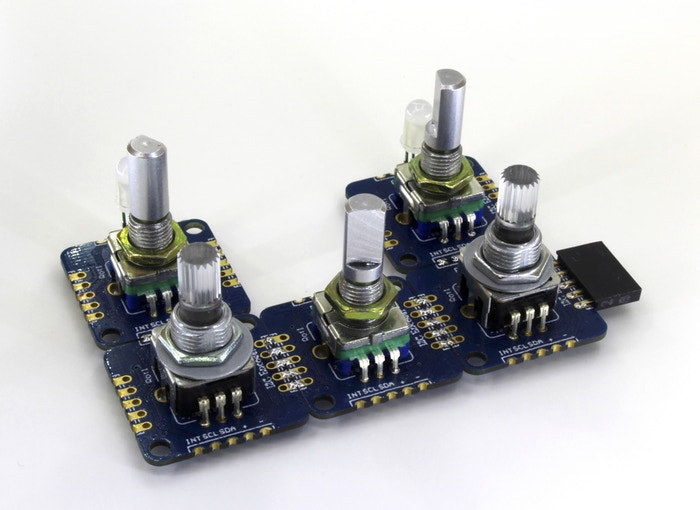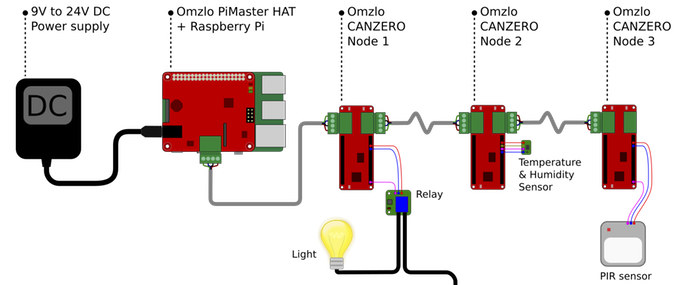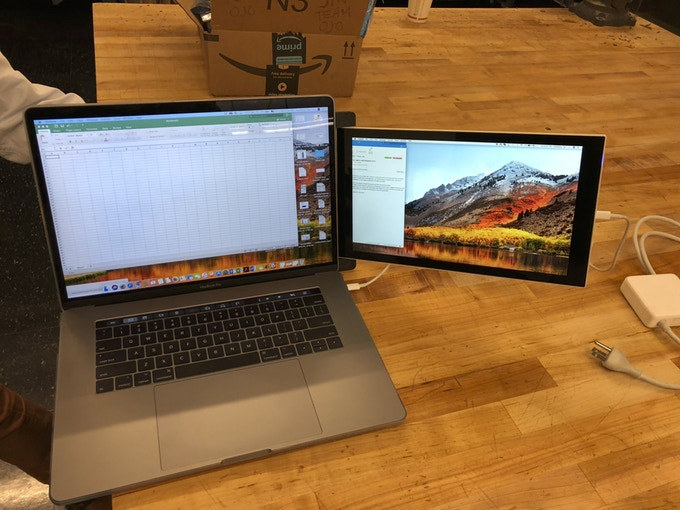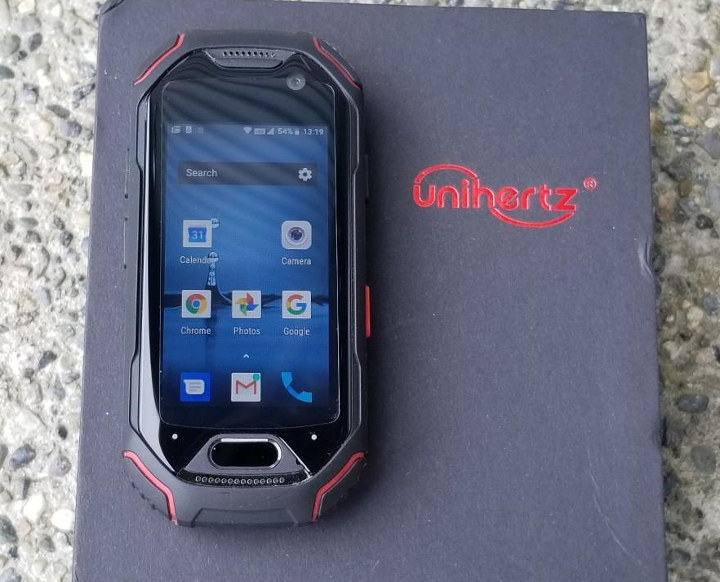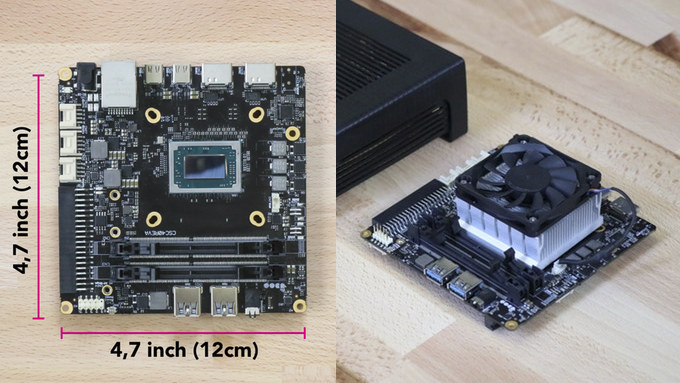Hicat launched HICAT.Livera machine vision board for robotics projects on Kickstarter two year ago. The company second project is still related to robotics and machine vision, but geared towards a different target audience, as ARCO robot aims to offer an augmented reality gaming experience to kids, although it’s still hackable/customizable as we’ll see below. The hardware part is mostly comprised of ARCO ROVER robot, and a Bluetooth controller that can be stored in ARCO’s inner capsule, where it recharges and communicates with ARCO through a magnetic pogo connection joint. The listed specifications are rather limited: ARCO ROVER Bluetooth connectivity (nRF52 WiSoC) 10 RGB LEDs Battery – Good for about one hour Power Supply – Via USB type C port Dimensions – 8.9 x 7 x 6.5 cm Weight – ~180 grams Controller Bluetooth (nRF52) Sensor – 3-axis accelerometer for motion detection Trigger and rocker Battery – Good for about one […]
Tachyon Arduino Zero Compatible Board Features Microchip SAMD51 Arm MCU @ 120 MHz (Crowdfunding)
Most Arm based Arduino compatible boards come with a Microchip SAMD21 Arm Cortex-M0+ MCU clocked at up to 48 MHz since this is the microcontroller found in the official Arduino Zero and MKRZero boards and comes with proper support in the Arduino IDE. But last year, Microchip introduced SAMD5x Arm Cortex-M4 microcontroller family which offers devices that are pin-to-pin compatible with SAMA2x microcontrollers but with better performance, and more memory and storage. So the guys at Rabid Prototypes decided to make Tachyon, a tiny Arduino Zero compatible board based on SAMD51 MCU for people wanting more oomph out of their Arduino board. Tachyon board specifications: MCU – Microchip ATSAMD51G18A Arm Cortex M4F @ 120 MHz with 256KB flash, 128 KB RAM I/Os Digital I/O pins – 14x w/ 12x PWM Analog input pins – 6x 12-bit ADC channels Analog output pins – 2x 10-bit DACs Operating voltage – 3.3V I/O […]
Connect Multiple Rotary Encoders to Arduino, ESP8266, Raspberry Pi, etc… with I2C Encoder V2 (Crowdfunding)
Rotary encoders are pretty common devices that convert the angular position of a shaft to analog or digital output signals with quadrature-encoded A / B pulses the most common way of reporting the position to the micro. So for each encoder you’d need 2-pin, and if your project use many of those you may quickly run out of pin, interrupts, etc… Simone Caron has decided to tackle this issue by creating an I2C encoder board, which works with various encoders, and whose second revision is now offered on Kickstarter. The I2C Encoder V2 board supports standard mechanical encoders, illuminated RGB encoders, and clickable rotary encoders, each of which may be with or without dent. The board also comes with 3 GPIOs following RGB LED footprint, but also usable as PWN, GPIO, or ADC, and each board’s I2C address can be configured with some soldering on A0 to A6 pins. Finally, […]
Tail it is a Family of WiFi & Cellular GPS Trackers for Things, Pets, and Bicycles (Crowdfunding)
We’ve previously written about Ping, a tiny Cellular GPS tracker that promised to last 3 months on a charge. The raising money part of the crowdfunding campaign itself was successfully with over one million dollars raised, but as with many such campaigns there have been delays, and some people still have to receive theirs, not to mention people complaining about poor battery life and other issues. But there seems to be another option now with Tail It Technologies now offering four different “Tail it” cellular GPS trackers (with WiFi too) for things, pets, and even one designed specifically for bicycles. The company has already sold their devices to thousands of customers in Norway, so they should be working, and on-time delivery should hopefully not be an issue. All four GPS trackers come with 2G, 3G, 4G, and WiFi connectivity, a 5-meter accuracy, and share the same electronics and firmware. Here’s […]
NoCAN IoT Platform Leverages Raspberry Pi & Arduino for CAN Bus Projects (Crowdfunding)
Many IoT projects rely on wireless connectivity through WiFi or Bluetooth, but in some cases it may be more reliable and convenient to use wired connectivity. The CAN Bus is a little like a low bandwidth Ethernet PoE solution for IoT, as it allows to transfer data over a serial connection while provided power at the same time, and can be daisy chain to support multiple boards. Omzlo’s NoCAN IoT platform provides a CAN bus solution leveraging Raspberry Pi 3 board through their PiMaster HAT acting as a CAN bus gateway, and Arduino compatible CANZERO boards to which you can connect sensors and actuators. Omzlo PiMaster HAT specifications: MCU – STMicro STM32F042 Cortex-M0 32bit ARM MCU – 48Mhz. Networking – 125000 bps CAN bus up to 300 meters range GPIO – Communicates with Raspberry Pi through SPI + GPIOs Security – Smart power switch with over-current protection. Power Supply – […]
Dual Display Laptop Made Possible with DUO Add-on Display (Crowdfunding)
I’m using a dual monitor setup at home since it’s just more convenient and increases productivity, but when I’m on the go, I have to revert to the single screen on my laptop. The guys at Mobile Pixels decided it was not good enough, and worked on providing a solution that allows you to take that dual display setup on the go. This gave birth to DUO, a screen that attaches to the back of your laptop, and that you can slide to the left or right of your laptop’s screen to add another display whether you may happen to be. DUO display specifications: Display Size & Resolution – 12.5″, 1920×1080 pixels Rotation – 270º full rotation, 180° presentation mode Connection – USB type C for power and video signal Power Consumption – 1.6 Watts; 0.3W in “rest mode”. Dimensions – 32.5 x 21.8 x 1.2 cm (ABS plastic) Weight […]
Unihertz Atom is an Android 8.1 Phone with a Tiny 2.4″ Display (Crowdfunding)
What we used to call phablet – smartphones with 5″ to 6″ display – are now simply called smartphones, as most companies now offer smartphones with larger displays since they are better suited for tasks like web browsing. Unihertz has gone the other way by launching Atom, an Android 8.1 smartphone with a tiny 2.4″ display. Demand does exist for such Phone, as while the Kickstarter campaign started a couple of days ago, the company has already raised close to $700,000 from around 3,000 backers. The “Atom” name clearly infringes on Intel’s trademark, so the model name is likely to change in a few days as has happened for “Atomwear” and “Nerdonic Atom X1“, but this did not affect the campaigns after they changed the names. Unihertz Atom smartphone specifications: SoC- Unnamed octa-core processor clocked at up to 2.0 GHz System Memory – 4GB RAM Storage – 64GB internal storage […]
UDOO BOLT AMD Ryzen Embedded V1000 SBC Goes for $229 and Up (Crowdfunding)
While Intel has been outing low cost and low power processors with less than 10W TDP over the years with their Bay Trail, Cherry Trail, Braswell, Apollo Lake, and now Gemini Lake processors, AMD has not really ventured into the low power space, and the latest announcements about 10-12W processors was for their Embedded G-Series J Family, which I have not seen in many products. More recently, the company introduced Ryzen Embedded V1000 family of processors with 4 to 8 Zen cores, 4K support, 10 GbE interface, and more with a TDP of 12 to 25W for Ryzen Embedded V1202B & V1605B dual / quad core processors. The latest x86 UDOO board – dubbed UDOO BOLT – will be one of the rare AMD development boards available on the market with pricing starting at $229. Two versions of the board will be available: UDOO BOLT v3 with Ryzen Embedded V1202B, […]


